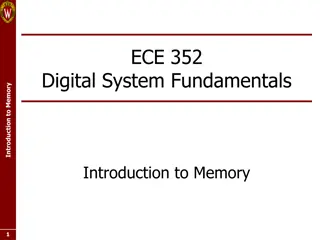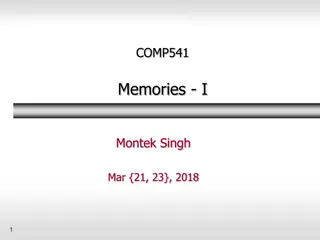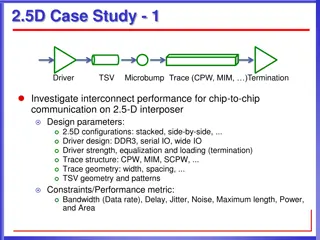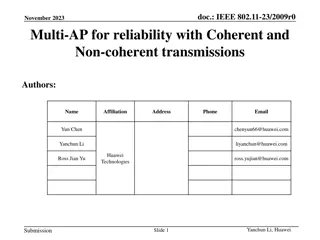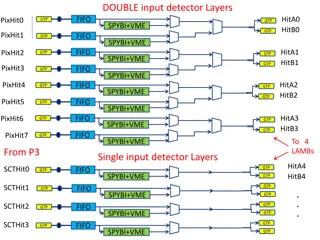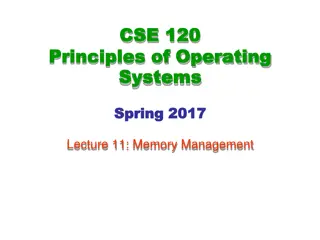TileLink: A Protocol for Coherent Memory in System-on-Chip
Modular verification approach with TileLink system components for SoC memory, emphasizing composable specifications for correctness and configuration flexibility. Explore memory semantics, consistency, and challenges in creating good composable specifications.
Download Presentation

Please find below an Image/Link to download the presentation.
The content on the website is provided AS IS for your information and personal use only. It may not be sold, licensed, or shared on other websites without obtaining consent from the author.If you encounter any issues during the download, it is possible that the publisher has removed the file from their server.
You are allowed to download the files provided on this website for personal or commercial use, subject to the condition that they are used lawfully. All files are the property of their respective owners.
The content on the website is provided AS IS for your information and personal use only. It may not be sold, licensed, or shared on other websites without obtaining consent from the author.
E N D
Presentation Transcript
Testing Composable Specifications Ken McMillan Microsoft Research
Case study TileLink is a protocol for implementing a coherent memory in a system-on-chip (SoC). Goal: a formal, modular specification of TileLink Specify the protocol Prove that it implements correct memory semantics Rigorously test component implementations Allow rapid configuration of SoC designs
TileLink system Hierarchy of memory system components for SoC using a common interface protocol. CORE DIR MEM L2$ CORE NET DIR MEM CORE L2$ DIR MEM TL TL TL TL Hierarchy implements weakly consistent memory model.
Modular verification General approach: Write generic formal specifications of components Verify components locally against specifications Infer that systems of such components are correct Composable specifications: Correctness of components implies correctness of system. With a composable specification, we can assemble arbitrary configurations of components. Some composable specifications are better than others, however
Good composability Assume/guarantee specifications A conjunction of temporal properties of interfaces Assume/guarantee relationships ? A: ? (?? ?) B: ? (?? ?) A B ? composable! A B: ?(? ?) This proof is checkable in P-time We want our specifications to be composable by construction .
Memory semantics op(loc,kind,addr,data) Memory operations: read write atomic CPU Happens-before relation on operations: happens-before(??1,??2) loc(??1) = loc(??2) time(??1) < time(??2) (addr(??1) = addr(??2) atomic(??1) atomic(??2)) Consistency: A sequence of ops is consistency if every read sees value of most recent write. Weak consistency: A set of operations is weakly consistent if there exists an ordering ? s.t: ? respects happens-before ? is consistent
Problem How do you write a good composable specification for a system if its key property refers to all events in the system? How do we witness the serialization ?? How do local operations fit into the global serialization?
Solution Add a reference object . Constructs the witness for ?. Verifies consistency ? as it is constructed create create : op loc stamp commit : stamp unit eval : stamp value commit ref. eval mem happens-before(X,op(stamp)) committed(X) commit(stamp): assumes assumes committed(stamp) value = eval(stamp): guarantees value = result(?,op(stamp)) These operations allow us to define the semantics of the system interfaces.
TileLink system Hierarchy of memory system components for SoC using a common interface protocol. CORE DIR MEM L2$ CORE NET DIR MEM CORE L2$ DIR MEM TL TL TL TL
TileLink interface protocol Protocol messages implement Coherent requests (MESI) Invalidation Ordered, non-coherent operations Interface has two roles: Client processor Manager memory Typical transaction flow at interface client Acquire Finish Probe Release Grants manager
Writing a good composable spec Specification has two parts: Temporal properties of interface Assume/guarantee relationships between properties Interface properties of two types: Interface protocol properties Semantic properties, relative to reference object
Semantic interface properties These properties refer to the reference object to define ordering and data values at the interface. Manager-side properties M[1]: Data in cached Grant must match ref.mem. M[2]: If uncached resp. then committed(stamp) M[3]: If uncached resp. then data = eval(stamp) Client-side properties C[1]: Data in cached Release must match ref.mem. C[2]: If uncached req. then happens-before(X,stamp) implies requested(X). C[3]: If uncached resp. then data = eval(stamp)
Commitment properties The coherence state determines what commitments are allowed on either side of the interface. This is the function of coherence. Client-side commitments: SC[1]: Read may be committed on client side only if interface has shared or exclusive permissions. SC[2]: Write may be committed on client side only if interface has exclusive permissions. Manager-side properties SM[1]: Read may be committed on manager side only if interface has shared or invalid permissions. SM[2]: Write may be committed on manager side only if interface has invalid permissions. Note: client side means any component left of the interface.
Assume/guarantee relationships An L2 cache has TileLink interfaces on processor side and memory side. ?? ?? ?? ?? ???? ???? ? ??? ??? ??? ??? ??? reference object
Assume/guarantee relationships An L2 cache has TileLink interfaces on processor side and memory side. ?? ?? ?? ?? ???? ???? ? ??? ??? ??? ??? ??? reference object ,?? ??,?? ,?? ??? ,?? ??? ,?? ,??? ,??? P,R: ?? P,R: ???,?? P,R: ???,?? P,R: ?? Checking this proof is a purely syntactic operation ??? ? ???
Formal proofs We can now formally verify components in isolation against their assume/guarantee specifications: Reording buffer Hierarchical cache Processor, memory, etc. These are simple abstract component models, intended to show that the specification has the intended implementations. Show key property that protocol is insensitive to message re- ordering. In the process, specification was corrected. Because our assume/guarantee specification is composable, we know that hierarchies built from these components implement a weakly consistent shared memory.
Compositional testing From an assume/guarantee specification, we can automatically generate a test environment. ?? ?? ?? ?? check check ?2 RTL ???? generate ???? generate ??? ??? check ??? ??? ??? reference object Tested two RTL level components with randomized generation using Z3: L2 cache bank Snooping hub
Testing results Compositional testing revealed currency errors in the RTL in under 1s (< 100 cycles) Unit testing provides much greater flexibility in covering internal corner cases Randomized specification-based testing reduces bias Latent bugs Most bugs could not be stimulated in integration test Latent bugs affect re-usability Importance of composability All system-level errors exposed to unit testing Gain confidence that components can be assembled into arbitrary configuration.
Conclusion Good composable specification is such that: Correct component imply correct system The proof of this is efficiently checkable Global properties (such as memory consistency) Reference object + temporal assume/guarantee Allows local specification of interface semantics Composable TileLink interface spec provides: Documentation of the interface Ability to reason formally about specification Efficient and rigorous test to find latent bugs Composable specifications provide a way to formal verification experts to provide value in an environment where most engineers do not have formal skills.
Specification as a social process The specification develops over time in collaboration with the system architects. Ambiguities in informal specs must be resolved. Initial formal spec almost certainly does not reflect designers intention. Mismatch with implementation may indicate properties should be strengthened or weakened for efficiency. Over time the formal spec becomes a valuable document. Encapsulates design knowledge. Allows rigorous testing and verification.













